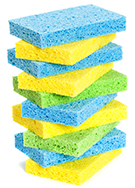
Norbert: Dave, pass me the nanosponges, I've got to clean up toxins in my blood!
Dave: They're not really tiny sponges, are they?
Norbert: No, but they act like tiny sponges by trapping toxins that damage healthy cells.
Nanosponges are ninety times smaller than our red blood cell, but they can absorb between thirty and nine hundred cell-damaging toxin molecules.
Imagine these nanosponges flooding your body when you're infected by bacteria such as Streptococcus and Staphylococcus, families of bacteria that includes MRSA, which is deadly.
These two pathogens can be resistant to many antibiotics, and they produce pore-forming toxins. These toxins insert themselves in the cell membrane creating holes that end up killing the cell, including red blood cells.
But in a study with mice, remarkably, 90% of mice treated with the nanosponges before a MRSA infection survived. Even if the nanosponges were given after a MRSA infection, 44% of mice still survived.
The nanosponges are made out of a polymer, the same biodegradable material used in some implants. Then they're covered with pieces of red blood cell membrane to cloak them from the immune system - otherwise they'd be immediately removed by white blood cells.
Toxins that come into contact with pieces of red blood cell membrane attach to the nanosponges, form pores, and are trapped by the core polymer. Eventually they're eliminated by the liver.
The strength of this therapy is that it works on a number of toxins compared with other treatments which only target one specific toxin. This technology is promising because it has the potential to be used in other treatments, even in delivering cancer-killing drugs.